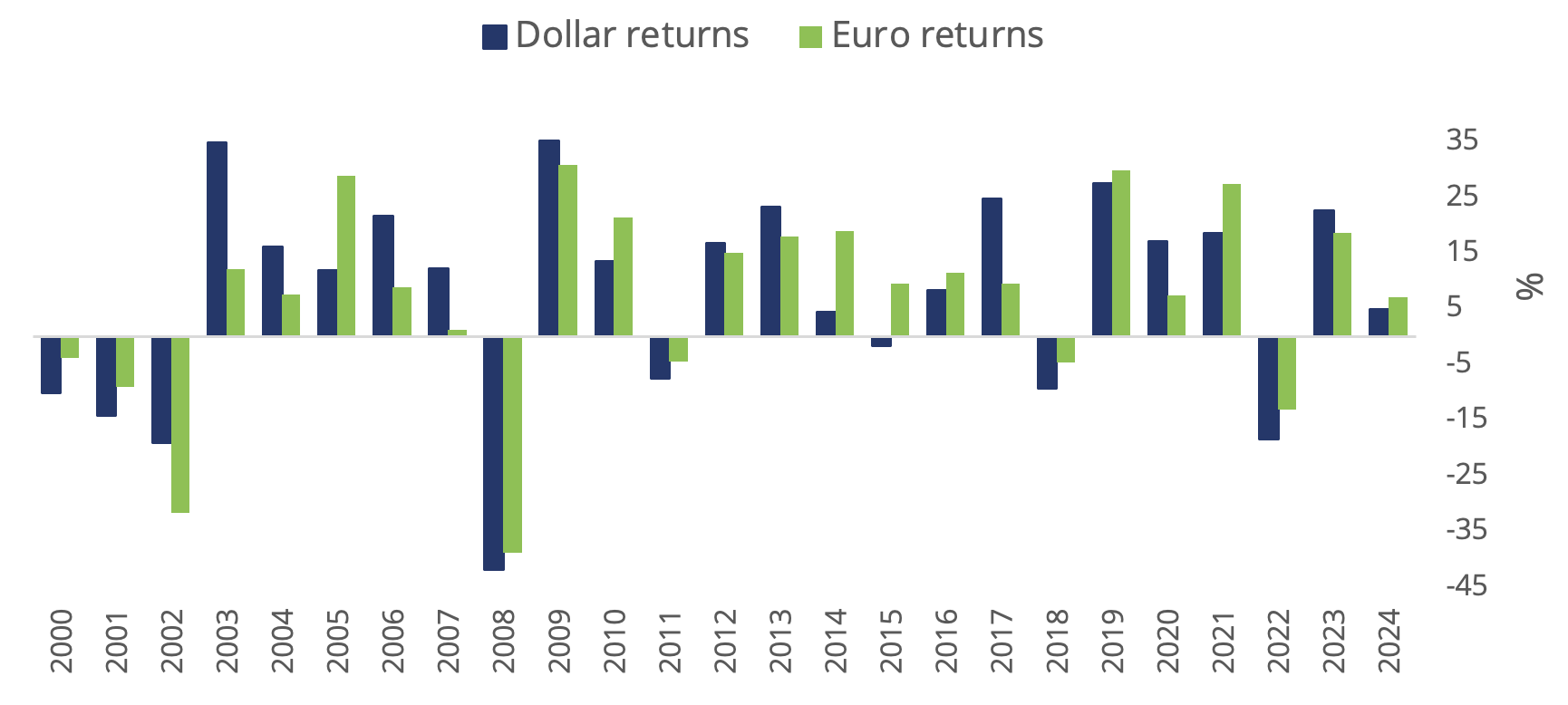
Stocks extended gains in February, lifting the STOXX® Global 1800 index to a record high, after better-than-expected US labour market and corporate earnings reports.
The STOXX Global 1800 jumped 4.3% in the month when measured in US dollars and including dividends[1], and reached a record high on a price level. It rose 4.7% in February when measured in euros. The STOXX® World AC index also added 4.3% in dollars in the month.
The Eurozone’s EURO STOXX 50® added 5.1% in euros, while the pan-European STOXX® Europe 600 advanced 2%[2] and reached an all-time high on a price level. The STOXX® North America 600 gained 5.4% in dollars, while the STOXX® USA 500 rose 5.6%. The STOXX® Asia/Pacific 600 climbed 1.9% in dollars. The STOXX® Developed World climbed 4.2% and the STOXX® Emerging Markets gained 4.7%.
Figure 1: STOXX Benchmark indices’ February risk and return

Figure 2: STOXX Equity World indices’ February risk and return

Germany’s DAX® rose 4.6% in the month. MDAX®, which gauges the performance of German mid-caps, decreased 0.5%.
| For a complete review of all indices’ performance last month, visit our February index newsletter. |
Economy, earnings paint bullish picture
The U.S. economy added 353,000 jobs in January, the government said on February 2, nearly twice as much as economists had forecast. [3] The consumer price index rose an annual 3.1% in January, down from 3.4% in December, the U.S. Bureau of Labor Statistics said February 13. Boosting stocks further were earnings reports in the month from the likes of Nvidia, Amazon and Meta, which smashed analysts’ estimates.
Figure 3: Total annual % returns for STOXX World AC index

Figure 4: Select STOXX benchmarks’ returns since 2023

Volatility drops
The EURO STOXX 50® Volatility (VSTOXX®), which tracks EURO STOXX 50 options prices, fell to 13.8 at the end of last month from 14.8 in January. A higher VSTOXX reading suggests investors are paying up for puts that offer insurance against stock price drops. The VDAX-New®, which measures volatility in German equities, eased to 12.9 from 14.2 in January.
Factor investing
The Momentum signal ruled across geographies, according to the STOXX Factor indices (Figure 5). The Low Risk factor was the weakest signal in the month.
Figure 5: STOXX Factor (Global) indices’ February risk and return characteristics

Climate benchmarks
Among climate benchmarks, the STOXX® Global 1800 Paris-Aligned Benchmark (PAB) rose 4% and the STOXX® Global 1800 Climate Transition Benchmark (CTB) added 3.8%. The PAB and CTB indices follow the requirements outlined by the European Commission’s climate benchmarks regulation.
Within the STOXX Low Carbon indices, the EURO STOXX 50® Low Carbon (+4.8%) underperformed the EURO STOXX 50 by 31 basis points. Elsewhere, the STOXX® Global Climate Change Leaders (+0.5%), which selects corporate leaders that are publicly committed to reducing their carbon footprint, underperformed the STOXX Global 1800 by 384 basis points last month.
Sustainability indices
The STOXX® Global 1800 ESG-X index gained 4.5% in the month. The STOXX® ESG-X indices are versions of traditional, market-capitalization-weighted benchmarks that observe standard responsible exclusions.
Within indices that combine exclusions and best-in-class ESG integration, the EURO STOXX 50® ESG index rose 4.3%. Germany’s DAX® 50 ESG index (+4.4%), which excludes companies involved in controversial activities and integrates ESG scoring into stock selection, lagged the benchmark DAX’s return in the month.
Among other STOXX sustainability families, the STOXX® Global 1800 ESG Broad Market added 4.3% in the month. The STOXX ESG Broad Market indices apply a set of compliance, product involvement and ESG performance exclusionary screens on a starting benchmark universe until only the 80% top ESG-rated constituents remain.
The STOXX® Global 1800 ESG Target rose 3.4%, the EURO STOXX® ESG Target gained 2.7% and theDAX® ESG Target added 4.6%. The STOXX and DAX ESG Target indices seek to significantly improve the benchmark portfolio’s ESG profile while mirroring its returns as closely as possible. Through a series of constraints, the indices implement an optimization process to maximize the overall ESG score of the portfolio while limiting the tracking error to the benchmark.
The STOXX® Global 1800 SRI advanced 4.7%. The STOXX SRI indices apply a rigorous set of carbon emission intensity, compliance and involvement screens, and track the best ESG performers in each industry group within a selection of STOXX benchmarks.
Finally, the DAX® ESG Screened added 4.5% in the month. The index reflects the composition of the DAX benchmark minus companies that fail to pass norms-based and controversial weapons screenings, meet minimum ESG ratings or are involved in certain business activities considered undesirable from a responsible investing perspective.
Thematics, dividend strategies
Twenty of 34 STOXX® Thematic indices outperformed the benchmark STOXX Global 1800 last month. The STOXX® Global Lithium Miners and Producers index was the best performer after adding 13.6%.
Dividend strategies had losses in dollars. The STOXX® Global Maximum Dividend 40 (-2.1%) selects only the highest-dividend-yielding stocks. The STOXX® Global Select Dividend 100 (-1.1%) tracks companies with sizeable dividends but also applies a quality filter such as a history of stable payments.
Minimum variance
Minimum variance strategies struggled last month. The STOXX® Global 1800 Minimum Variance rose 1.8% and the STOXX® Global 1800 Minimum Variance Unconstrained fell 0.3%.
The STOXX Minimum Variance Indices come in two versions. A constrained version has similar exposure to its market-capitalization-weighted benchmark but with lower risk. The unconstrained version, on the other hand, has more freedom to fulfill its minimum variance mandate within the same universe of stocks.
[1] All results are total returns before taxes unless specified.
[2] Throughout the article, all European indices are quoted in euros, while global, North America, US, Japan and Asia/Pacific indices are in dollars.
[3] AP, “The US didn’t just avoid a recession — it’s adding hundreds of thousands of new jobs,” February 2, 2024.
[4] Figures in parentheses show last month’s gross returns.



